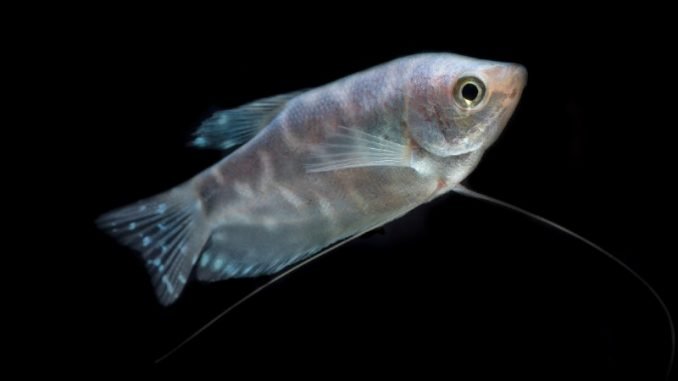
The opaline gourami (Trichopodus trichopterus) is part of the Osphronemidae family of fish. Gouramis are freshwater fish that are native to Southeast Asia.
Opaline gouramis are popular amongst beginner-level aquarists due to their easy-going nature and how little daily attention the fish require. Aquarists at every skill level enjoy caring for opaline gourami fish.
With that being said, dwarf gouramis are still the number one choice for a home aquarium, overshadowing the opaline gourami.
Fish keepers caring for opaline gouramis can expect to see the gourami swimming speedily in the fish tank and interacting calmly with other tank mates. Watching opaline gouramis swim around the tank is entertaining and brings character to the aquarium.
TABLE OF CONTENTS
Opaline Gourami Facts & Overview
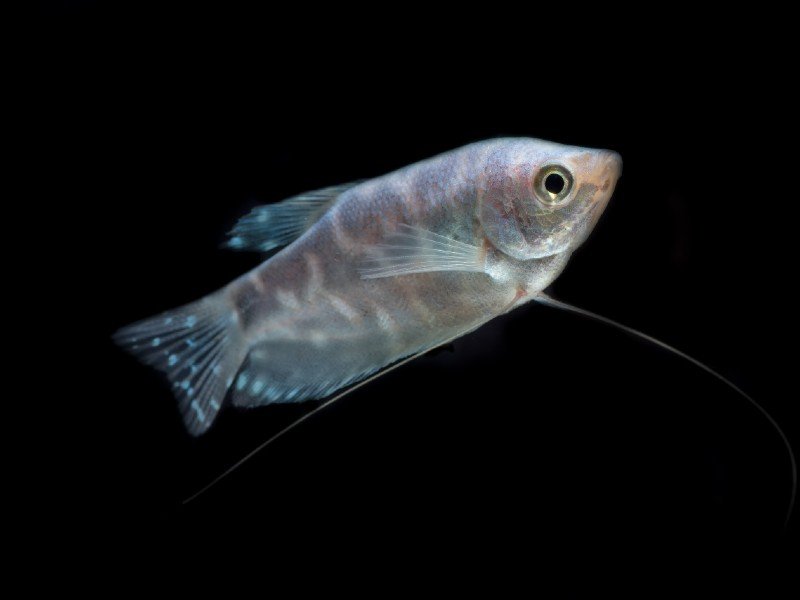
| Category | Rating |
| Care Level: | Easy |
| Temperament: | Peaceful |
| Color: | Pale blue body with a marbled pattern across the body that varies from fish to fish |
| Lifespan: | 4–6 years |
| Size: | Up to 6 inches long |
| Diet: | Omnivore |
| Family: | Osphronemidae |
| Minimum Tank Size: | 35 gallons |
| Tank Set-Up: | Freshwater community tank |
| Compatibility: | Compatible with non-aggressive fish of the same size |
Trichopodus trichopterus is the opaline gourami’s scientific name. Opaline gourami fish are also known by other common names such as three-spot gourami, blue gourami, and gold gourami.
The name “three-spot gourami” suits the opaline gourami because of the two unique spots that the gourami has on its body that align perfectly with its eye (the third spot). Identifying the opaline gourami amongst other gouramis is easy, thanks to its unique appearance.
Opaline gouramis, blue gouramis, three-spot gouramis, and gold gouramis are all the same fish bred to display slightly different colors and markings.
The three-spot gourami is the only opaline gourami found in the wild and is native to China, Cambodia, Malaysia, Laos, Myanmar, Thailand, Singapore, and Vietnam, through to Java, Sumatra, and Borneo.
Three-spot gouramis cost on average less than $3 per fish, which is incredibly cheap. This gourami species is readily available in most large pet shops, which is why the opaline gourami is sold at such a competitive price.
Appearance & Behavior
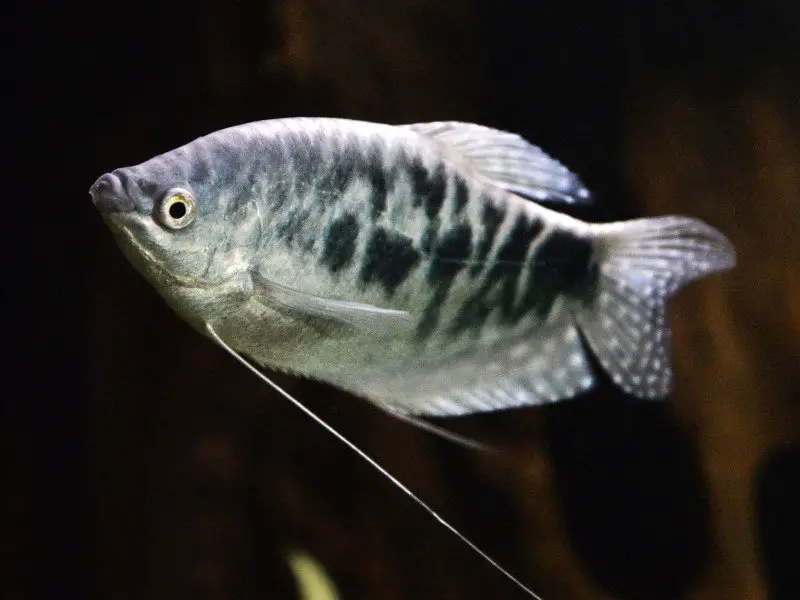
This opaline gourami fish has various physical characteristics. Aquarists appreciate adding different types of this species of fish into their aquarium as the fish all display unique physical qualities and patterns.
Here is an overview of how different varieties of opaline gourami look:
- Opaline Gourami — blue with grey/black stripes and across their bodies. Typical opaline gouramis have spots and individual patterns on their fins and tails, too.
- Three-spot Gourami — has two vivid black spots on either side of its body. A three-spot gourami’s spots fade when the fish is under stress, and its body remains a pale grey color.
- Blue Gourami — has a light blue body with soft marbling. The blue gourami still has two distinct spots on each side of the fish’s body, making it clear that it is an opaline gourami fish.
- Gold Gourami — has yellow/gold body decorated with black stripes and spots. The fish’s fins and tail display most of the gold gourami’s patterns.
- Lavender Gourami — has two distinct spots on its body, giving its distinct Trichopodus trichopterus look. Lavender gourami fish have pale lavender bodies that sometimes look metallic in certain aquarium lighting.
These fish are all the same but bred to display different colors and patterns. Plenty of gourami fish display entirely different physical characteristics from the opaline gourami, often confusing first-time aquarists.
The difference between male and female opaline gourami fish is easy to spot. Male fish are slim and smaller than female opaline gourami fish. Female opaline gouramis have short, rounded dorsal fins, along with rounded bellies.
Distinguishing between male and female opaline gouramis is easy once the gouramis have reached full maturity.
Stressed opaline gouramis will look dull in color, and the distinct black spots on the gourami’s body will fade. Changes in appearance could also indicate disease or infection, which is why performing weekly physical checks on opaline gouramis is vital for keeping the fish healthy and happy.
Typical Behavior
Gourami fish do well in community tanks. The opaline gourami is peaceful but can be territorial and bicker with other male fish when it feels threatened.
Pairing opaline gouramis with appropriate fish is vital for keeping a peaceful aquarium. Distressed opaline gouramis will swim quickly around the tank or look for tank accessories and foliage as hiding spaces.
Opaline gourami fish are extremely quick eaters and devour their food faster than other fish in the tank. Keeping an eye out to ensure that all fish get enough food is essential in an opaline gourami tank.
One of the most special things about opaline gouramis is that they come to the surface of the tank to get air. Watching opaline gouramis surface for air is quite the spectacle. Opaline gouramis come to the surface for air because of the labyrinth organ that the fish uses for respiration in air. Keeping opaline gouramis in a long tank is better than keeping them in a tall tank to make it easier for the fish to surface for air.
Opaline gouramis also react to seeing their owner, which is unique behavior for a fish.
Opaline gouramis swim around all areas of the tank. Gouramis in a tall fish tank will stay near the surface in order to make coming up for air easier. Gouramis might hide and shy away in a new environment, but as soon as the opaline gouramis acclimate to the new environment, the fish stay out in the open waters of the tank.
Opaline gouramis are active in the day and rest at night. Maintaining natural day to night lighting in the fish tank will benefit the gouramis.
Opaline Gourami Care
Opaline gouramis are easy to care for. Gouramis are hardy fish that can tolerate varying water conditions and environments.
The most important feature an opaline gourami tank should have is plenty of swimming space. Opaline gouramis are attractive fish. Opting for tank accessories and a dark-colored substrate that will make the opaline gouramis’ color pop makes the fish stand out in the tank.
Opaline gouramis love swimming in tanks decorated with live plants. Live plants give the opaline gourami fish hiding spaces and areas to explore, making for a more comfortable tank environment.
Performing regular water changes is vital even though opaline gouramis can survive in water with low oxygen levels. Failing to keep the aquarium water clean will result in the gouramis and other fish in the tank becoming sick.
Disease
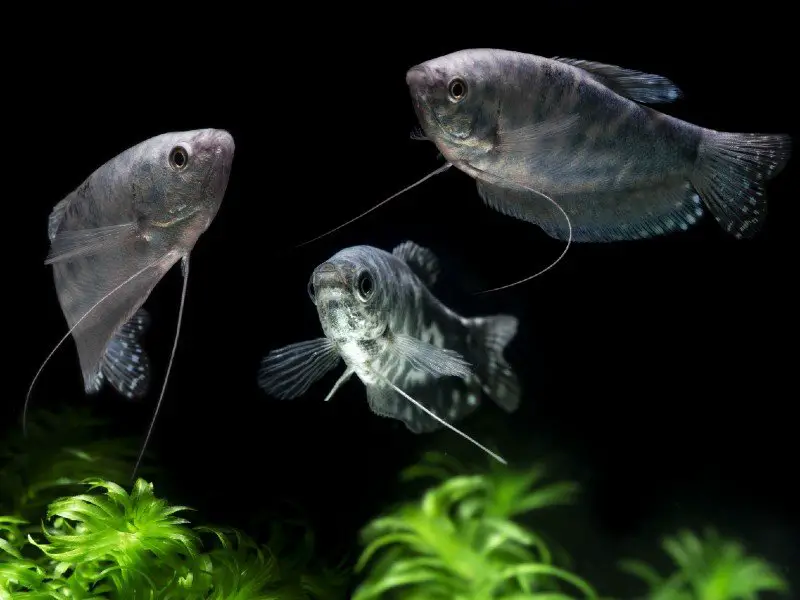
Opaline gouramis are prone to developing diseases and infections associated with captive aquarium fish. The best way to avoid disease and infection is to keep new fish in quarantine for two weeks and to perform regular water changes in the aquarium. Here are some diseases and infections to look out for:
- Hole in the head — Parasites cause hole in the head. Opaline gourami fish suffering from a hole in the head will need antibiotics.
- Bacterial infections — Poor water conditions cause fish to become weak and susceptible to bacterial infections. Keeping the tank clean will prevent and cure bacterial infections.
- Constipation — Constipation will make it hard for opaline gouramis to surface for air. Fish suffering from constipation will stay near the substrate. Starving the fish for a day or so should unblock the fish.
Some conditions only pass with the help of antibiotics. Remove infected fish into a hospital tank until all of the fish have fully recovered.
Habitat and Tank Requirements
The opaline gourami fish does not occur in the wild, but the three-spot gourami does. Setting up the tank to mimic where the three-spot gourami lives in the wild is advised as both the opaline gourami and three-spot gourami are the same fish with a slightly different appearance.
Keep the water in an opaline gourami tank slow-moving. Adding as many natural plants as possible without cluttering the tank will also benefit the opaline gourami and will keep the fish in high spirits.
Tank Conditions
- Water type — Opaline gourami fish are freshwater fish. Tap water left to sit for several days is the best to use for filling up a freshwater aquarium. Dechlorinators will help balance the water quickly when time is short.
- Ideal tank size — Juvenile opaline gouramis will live happily in a 20-gallon fish tank. Once the opaline gouramis reach full maturity, the fish need to move into a tank that holds 35 gallons of water or more.
- Desired water temperatures — Flexible water temperatures between 73 to 82°F (23 to 28°C) are ideal for opaline gourami tanks. Keeping the water temperature constant is crucial for the gourami’s health.
- Substrate — Opaline gourami fish look striking against a dark sand substrate. Both sand and gravel substrates are suitable for opaline gouramis.
- Plants and accessories — Decorating an opaline gourami tank with plants will keep the fish happy and add a pleasant ambiance to the tank. Most freshwater fish species appreciate the addition of live plants, so add plants like water lettuce, hornwort, java fern, Amazon sword, and Amazon frogbit to the freshwater tank.
- Water pH — Opaline gourami fish are particularly hardy when it comes to water pH levels in their aquarium. Gouramis can tolerate pH levels of between 6.0 and 8.8. Aquarists introduce opaline gouramis into tanks containing fussy fish because of the gourami’s versatility and tolerance of various water parameters.
- Filters and bubblers — Look for a sponge filter when shopping around for the best aquarium filter for opaline gouramis. Gouramis don’t like noise, so sponge filters are ideal and will keep the fish calm and relaxed.
Tank Mates
Opaline gourami fish are generally peaceful fish with territorial tendencies. Pairing the opaline gouramis with dominant fish could cause conflict in the tank. The best tank mates for opaline gouramis are similar-sized fish with a calm and peaceful temperament. Here is a list of the best tank mates for opaline gourami fish:
- Barbs — Barbs are colorful fish with lively personalities. Opt for peaceful barbs like a cherry barb in an opaline gourami tank.
- Characins — Characins are subtropical freshwater fish. Characins (e.g. tetras) come in various colors and patterns and will make an attractive addition to any freshwater tank.
- Loricariid catfish — Loricariid catfish are the largest type of catfish in their species. As bottom dwellers, the loricariid catfish spend most of their time relaxing at the bottom of the tank, searching for leftover food. Consider the bristlenose catfish as a tank mate.
- Loaches — Loaches are long and thin bottom-dwelling fish that like to keep to themselves. Loaches are native to Morocco and Eurasia.
Diet and Feeding
Opaline gouramis are easy to feed and will eat almost anything. Opaline gouramis will eat anything from commercial fish food pellets and flakes to live fresh or frozen food.
Feed opaline gouramis twice daily — once in the morning, and once in the evening, and only give the gouramis enough food to eat within a three-minute period. Opaline gouramis tend to overeat and become sluggish and tired.
A balanced diet of fresh brine shrimp, bloodworms, and fish food pellets is perfect for opaline gouramis. Feed gouramis live or frozen food three or four times a week.
Breeding
Male opaline gouramis show breeding behavior by making bubble nests and flaring their fins to attract female fish. Male gouramis will swim back and forth around the tank when the fish are ready to mate.
Opaline gouramis breed easily. Once the fry hatch, fish keepers should move the fry to a breeding box for safety. Perform frequent water changes to help the labyrinth organ develop properly.
Should You Get an Opaline Gourami for Your Aquarium?
Opaline gouramis are very easy to care for and can tolerate a wide range of water parameters, making this gourami species brilliant for community tanks. Aquarists looking for a fun fish that is easy to breed will have fun caring for opaline gouramis. The only time fish keepers should avoid keeping opaline gouramis in a tank is if the gouramis will need to share an aquarium with aggressive fish.
Opaline gouramis are lively and active and one of the few fish species that bond with their caregiver. Keeping opaline gouramis is fun and something the whole family can get involved in.

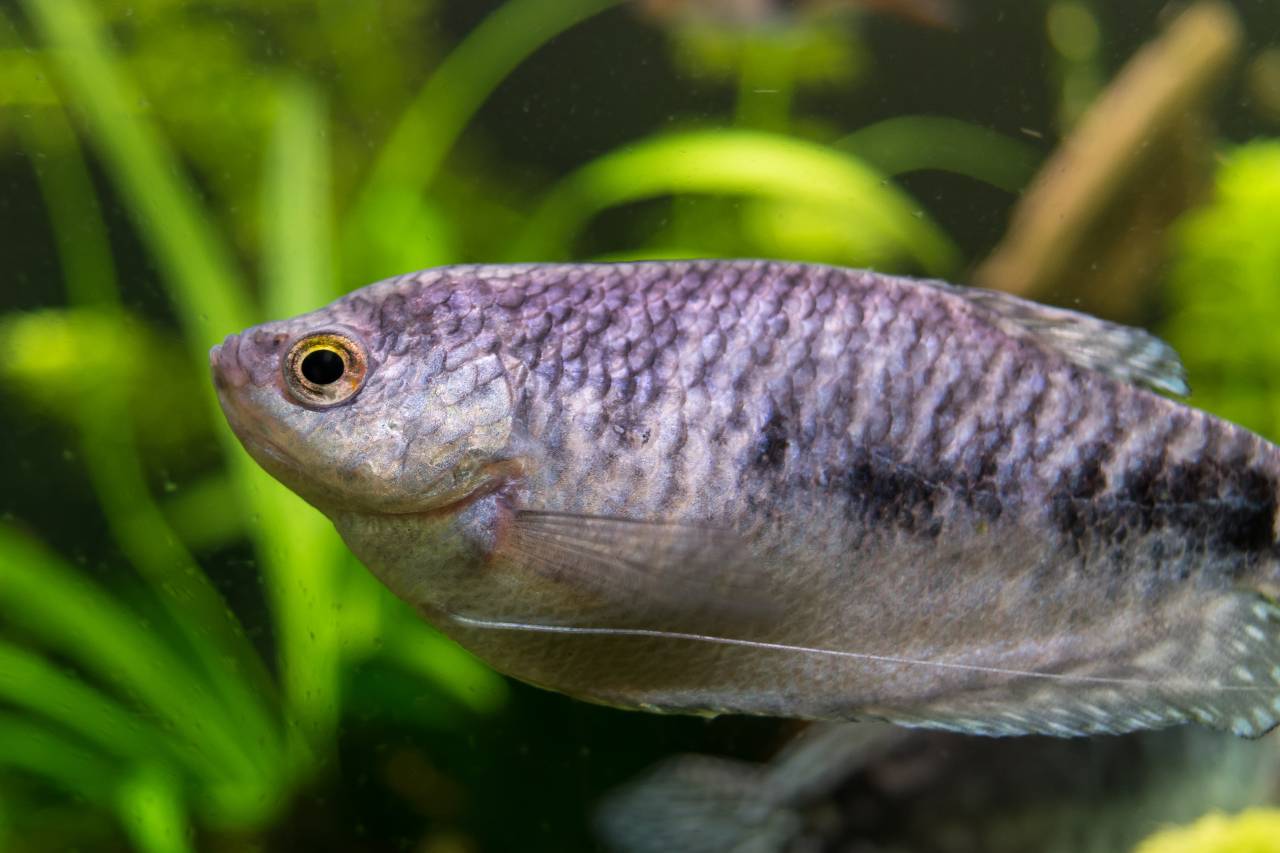
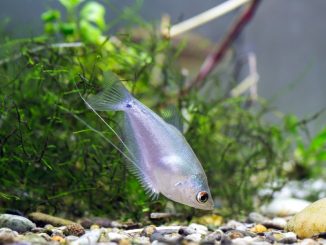
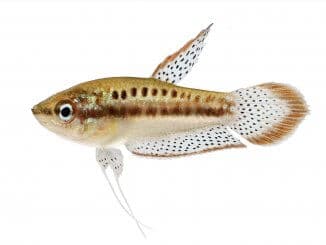

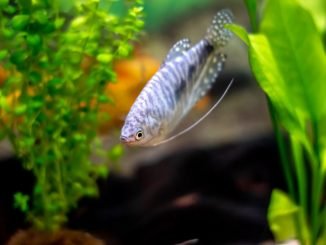
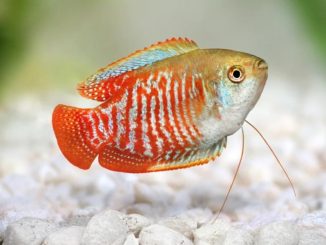
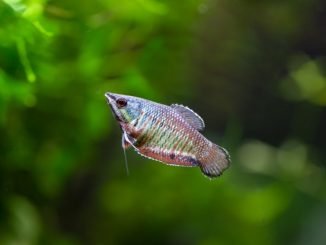
Be the first to comment